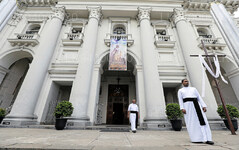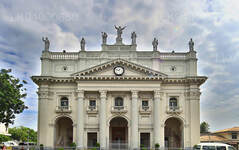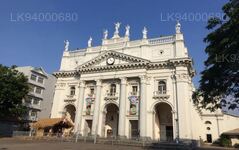
Città di Colombo
Colombo, la capitale dello Sri Lanka, è una città dinamica che fonde tradizione e modernità. Vanta un'architettura coloniale, vivaci mercati e sereni templi buddisti. Con una cucina variegata, uno skyline in continua crescita e splendide spiagge, è un vivace centro per gli affari, la cultura e il turismo, offrendo un punto di partenza ideale per esplorare le meraviglie dello Sri Lanka.
St Lucias Catherdral
St. Lucy of Sicily whose feast falls on December 13 is venerated the world over as the protectress against eye trouble. Legend has it that she had the most beautiful pair of eyes and that she pulled them out to present them to an unwelcome suitor who was enamored by their beauty. However, her eyes were miraculously restored to her more beautiful than before. Named after this virgin and martyr saint are St. Lucia’s Cathedral of Kotahena, the oldest and largest parish cathedral in Sri Lanka and the seat of the Archbishop of Colombo.
The 110-year-old cathedral had humble origins in a small chapel of wood and Cadjan built by the Oratorian fathers in 1760 when Ceylon was under Dutch occupation. This was replaced by a larger church of brick and mortar in 1782. When Ceylon was detached from the jurisdiction of the Archbishop of Goa in 1834, Rev. Fr. Vincenti Rosario was appointed the first Vicar-Apostolic of Ceylon and St. Lucia’s Cathedral became the first cathedral of Sri Lanka. Eventually, the foundation stone for a new cathedral building was laid to replace the old one. In 1873 Bishop H D Sillani and Rev. Fr. S Tabarrani, men of great vision and talent designed and initiated the building of St. Lucia’s Cathedral thus planting the seeds of grandeur and Lnagnificence of what was to be.
The Catholics of Colombo, the churches outside the city, and even the fisher folk contributed their share to the building fund. The cathedral cost Rs 160,000 to build which was an enormous amount in the last century, yet totally funded by the pious generosity of the Ceylonese Catholics of the time. Towards the end of 1887 the main body of the cathedral was completed and the blessing of the cathedral took place in December of that year. However the building of the cathedral took 30 years and was completed in 1902 when the scaffoldings were finally dismantled and the site cleared. The succeeding generations of parishioners and parish priests continued to embellish the cathedral with exquisite statues and sacred vessels often shipped from Europe. After a succession of European priests Rev. Fr. Nereus Fernando became the first Sri Lankan parish priest of the cathedral in 1956. Under the dynamic leadership of Rev. Fr. Rufus Benedict the cathedral was prepared for its centenary which was celebrated in December 1987. St. Lucia’s Cathedral Kotahena is the legacy of parishioners whose fervent faith aspired to build this magnanimous tribute to God. At the threshold of yet another century the cathedral stands unsurpassed in beauty and in magnificence as it has always stood over the last one hundred years.
Informazioni sul distretto di Colomb
Colombo è la città più grande e la capitale commerciale dello Sri Lanka. Si trova sulla costa occidentale dell'isola e adiacente a Sri Jayewardenepura Kotte, la capitale dello Sri Lanka. Colombo è una città vivace e trafficata, con un mix di vita moderna, edifici e rovine coloniali e una popolazione di 647.100 abitanti. La regione metropolitana di Colombo, definita dai distretti di Colombo, Gampaha e Kalutara, ha una popolazione stimata di 5.648.000 abitanti e si estende su una superficie di 3.694,20 km². Colombo è una città multietnica e multiculturale. È la città più popolosa dello Sri Lanka, con 642.163 abitanti che vivono entro i confini della città. La popolazione di Colombo è un mix di numerosi gruppi etnici, principalmente cingalesi, mori e tamil. In città vivono anche piccole comunità di persone di origine cinese, portoghese, olandese, malese e indiana, oltre a numerosi espatriati europei. La stragrande maggioranza delle aziende dello Sri Lanka ha sede a Colombo. Alcuni dei settori industriali includono prodotti chimici, tessili, vetro, cemento, pelletteria, arredamento e gioielleria. Nel centro città si trova il secondo edificio più alto dell'Asia meridionale: il World Trade Center.
Informazioni sulla provincia occidentale
La Provincia Occidentale è la provincia più densamente popolata dello Sri Lanka. Ospita la capitale legislativa Sri Jayawardenepura Kotte e Colombo, il centro amministrativo e commerciale della nazione. La Provincia Occidentale è divisa in 3 distretti principali: Colombo (642 km²), Gampaha (1.386,6 km²) e Kalutara (1.606 km²). Essendo il fulcro economico dello Sri Lanka, tutte le principali aziende locali e internazionali hanno sede in città, così come i principali negozi di stilisti e grandi magazzini, quindi preparatevi a concedervi un po' di shopping nella Provincia Occidentale. Avendo la popolazione più alta di tutte le province, quasi tutti i principali istituti scolastici dell'isola si trovano nella Provincia Occidentale. Le università della provincia includono l'Università di Colombo, l'Università di Sri Jayewardenepura, l'Università di Kelaniya, l'Università Aperta dello Sri Lanka, l'Università Buddista e Pali dello Sri Lanka, l'Università della Difesa Generale Sir John Kotelawala e l'Università di Moratuwa. La provincia occidentale ospita il maggior numero di scuole del paese, tra cui scuole nazionali, provinciali, private e internazionali.







































